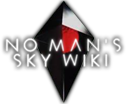Ddfairchildd (talk | contribs) mNo edit summary |
Thamalandis (talk | contribs) No edit summary Tag: Source edit |
||
| (10 intermediate revisions by 5 users not shown) | |||
| Line 1: | Line 1: | ||
| − | {{Version| |
+ | {{Version|Frontiers}} |
{{General infobox |
{{General infobox |
||
| name = Biome - Lush |
| name = Biome - Lush |
||
| Line 15: | Line 15: | ||
| discoveredlink = |
| discoveredlink = |
||
| platform = |
| platform = |
||
| − | | release = |
+ | | release = NextGen |
}} |
}} |
||
| Line 22: | Line 22: | ||
==Summary== |
==Summary== |
||
[[File:Roamer Mountain LushTefran3.PNG|thumb|A mountainous Earth-like world]] |
[[File:Roamer Mountain LushTefran3.PNG|thumb|A mountainous Earth-like world]] |
||
| + | [[File:Bubbly Glowy Sugary Crushy Diabetesy Causingy Planety.png|thumb|A lush planet undergoing corruption. Signs include bioluminescent grass and the presence of bubbles normally found in exotic bubble cluster worlds.]] |
||
Worlds with lush [[biome]]s are characterized by colorful grass covering most of the surface. These are essentially the Earth-like planets. Depending on the amount of flora, trees can be sparsely found or sprawl into lush forests. Occasionally, one can find "Barren Lush" worlds where there is an almost, if not complete lack of flora, save for hostile vine whips. When viewed from space, it looks like it's covered by a carpet of grass. The resources [[Paraffinium]], [[Star Bulb]] and [[Nitrogen]] can be found here. |
Worlds with lush [[biome]]s are characterized by colorful grass covering most of the surface. These are essentially the Earth-like planets. Depending on the amount of flora, trees can be sparsely found or sprawl into lush forests. Occasionally, one can find "Barren Lush" worlds where there is an almost, if not complete lack of flora, save for hostile vine whips. When viewed from space, it looks like it's covered by a carpet of grass. The resources [[Paraffinium]], [[Star Bulb]] and [[Nitrogen]] can be found here. |
||
| Line 29: | Line 30: | ||
Yellow stars in [[Norm galaxy|Norm]] and [[Harsh galaxy|Harsh]] galaxies have 2x higher chance to have lush planets, yellow stars in [[Lush galaxy|Lush]] galaxies have 4x higher chance, and yellow stars in [[Empty galaxy|Empty]] galaxies have the same chance as other star types. |
Yellow stars in [[Norm galaxy|Norm]] and [[Harsh galaxy|Harsh]] galaxies have 2x higher chance to have lush planets, yellow stars in [[Lush galaxy|Lush]] galaxies have 4x higher chance, and yellow stars in [[Empty galaxy|Empty]] galaxies have the same chance as other star types. |
||
| + | |||
| + | As of [[Origins]], some lush planets are undergoing ''exoticification'' or some form of corruption. There are multiple signs: |
||
| + | *The presence of bioluminescent grass and flora. |
||
| + | *Objects normally found in exotic planets are present and plentiful. |
||
| + | *Storms don't affect hazard protection. |
||
| + | *Abnormal weather (e.g. Corrupted Blood) |
||
| + | <!--- Someone please rephrase/improve this or make it sound better. I don't know what to call it so I made up a random term and a couple of stuff on these kinds of lush planets---> |
||
==Name generation== |
==Name generation== |
||
| Line 45: | Line 53: | ||
# Overgrown |
# Overgrown |
||
# Flourishing |
# Flourishing |
||
| + | # Grassy |
||
# Bountiful |
# Bountiful |
||
}} |
}} |
||
| Line 80: | Line 89: | ||
| 10. || Blissful || Lethal Humidity Outbreaks || Torrid Deluges |
| 10. || Blissful || Lethal Humidity Outbreaks || Torrid Deluges |
||
|} |
|} |
||
| + | |||
| + | ==Exotification== |
||
| + | A multitude of lush worlds have been observed to enter exotification, most common the bubble exotic corruption. This may imply that all bubble exotic worlds may have come from lost gaia worlds. A typical sign for exotification is the ship computer alerting the traveller to a boundary failure. |
||
| + | <gallery> |
||
| + | Mitanlei Prime.jpg|Mitanlei Prime's visual Exotification |
||
| + | Exotification Warning.jpg|Ship warning about Exotification |
||
| + | </gallery> |
||
==Civilised space== |
==Civilised space== |
||
Revision as of 22:39, 20 September 2021
| The subject of this article is from the Frontiers update.
The information from this article is up-to-date as of 15 February, 2022. |
The information from this article is up-to-date as of 15 February, 2022.
| Biome - Lush | |
|---|---|
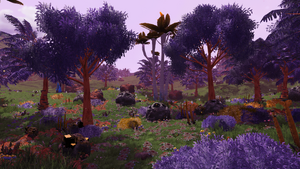
| |
| Type | Biome |
| Description | Earth-like planets. |
| Updated | NextGen |
Lush is one of the Biome varieties.
Summary
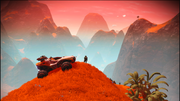
A mountainous Earth-like world
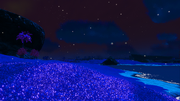
A lush planet undergoing corruption. Signs include bioluminescent grass and the presence of bubbles normally found in exotic bubble cluster worlds.
Worlds with lush biomes are characterized by colorful grass covering most of the surface. These are essentially the Earth-like planets. Depending on the amount of flora, trees can be sparsely found or sprawl into lush forests. Occasionally, one can find "Barren Lush" worlds where there is an almost, if not complete lack of flora, save for hostile vine whips. When viewed from space, it looks like it's covered by a carpet of grass. The resources Paraffinium, Star Bulb and Nitrogen can be found here.
These planets have the most varied types of Genera.
Some planets in survival and permadeath exist without aggressive sentinel presence.
Yellow stars in Norm and Harsh galaxies have 2x higher chance to have lush planets, yellow stars in Lush galaxies have 4x higher chance, and yellow stars in Empty galaxies have the same chance as other star types.
As of Origins, some lush planets are undergoing exoticification or some form of corruption. There are multiple signs:
- The presence of bioluminescent grass and flora.
- Objects normally found in exotic planets are present and plentiful.
- Storms don't affect hazard protection.
- Abnormal weather (e.g. Corrupted Blood)
Name generation
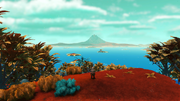
A lush planet with different colors.
The biome type is indicated in the information panel when the player exits their starship. This is procedurally generated by adding one of the following prefixes to the Planet or Moon text.
The sequence is taken from the game file.
- Rainy
- Verdant
- Tropical
- Viridescent
- Paradise
- Temperate
- Humid
- Overgrown
- Flourishing
- Grassy
- Bountiful
Conditions
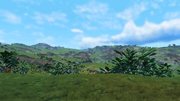
Some lush planets can be rather Earth-like.
- The weather here is the most ideal, as day and night temperatures don't enable hazard protection.
- Superheated rainstorms can occur. Hazard Protection drain is similar to being in a storm on a hot biome.
- Extreme weather lush worlds have seemingly everlasting rain, with superheated rainstorms occurring frequently. These storms are significantly more powerful, draining Hazard Protection in a similar rate as extreme heat storms in hot biomes.
Weather
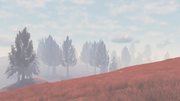
Extreme lush planets are rainy and have scalding hot rain storms.
| Sequence | Clear (No storms) | Normal | Extreme |
|---|---|---|---|
| 1. | Temperate | Boiling Puddles | Boiling Superstorms |
| 2. | Light Showers | Sweltering Damp | Intense Heatbursts |
| 3. | Mild Rain | Superheated Drizzle | Superheated Rain |
| 4. | Refreshing Breeze | Dangerously Hot Fog | Boiling Monsoons |
| 5. | Humid | Choking Humidity | Broiling Humidity |
| 6. | Pleasant | Mostly Calm | Painfully Hot Rain |
| 7. | Balmy | Occasional Scalding Cloudbursts | Torrential Heat |
| 8. | Mellow | Usually Mild | Blistering Floods |
| 9. | Beautiful | Blistering Damp | Scalding Rainstorms |
| 10. | Blissful | Lethal Humidity Outbreaks | Torrid Deluges |
Exotification
A multitude of lush worlds have been observed to enter exotification, most common the bubble exotic corruption. This may imply that all bubble exotic worlds may have come from lost gaia worlds. A typical sign for exotification is the ship computer alerting the traveller to a boundary failure.
Civilised space
- The lush biome is one of the 2 biomes to be considered candidates for Garden Worlds by the Arcadia Project, alongside the frozen biome.
Additional information
- The name generation and weather with their sequence are extracted from the 1.77 version of NMS_UPDATE3_ENGLISH.MBIN game file.
Release history
- Prior to 1.38 nearly all gaia planets in survival and permadeath had aggressive sentinel presences forcing the player to face some challenge at all times on any given biome.
- Prior to 1.38, lush worlds in certain areas experienced acid storms instead of cold storms.
- As of 1.38, heatstorms were added to lush worlds instead of acid storms. It would also replace most if not all cold storms. This coincided with the addition of desert worlds with nightly freezing temperatures.
